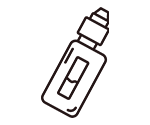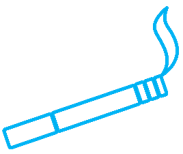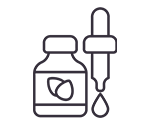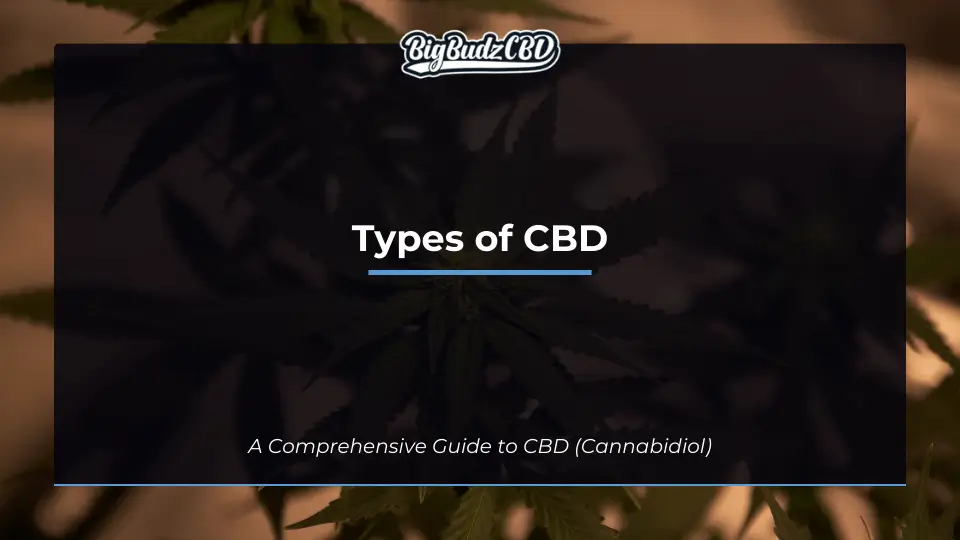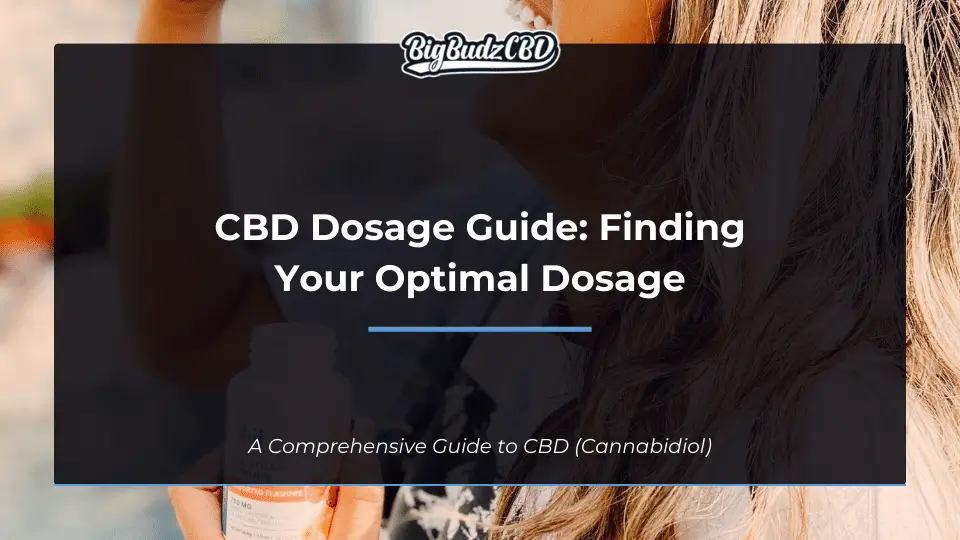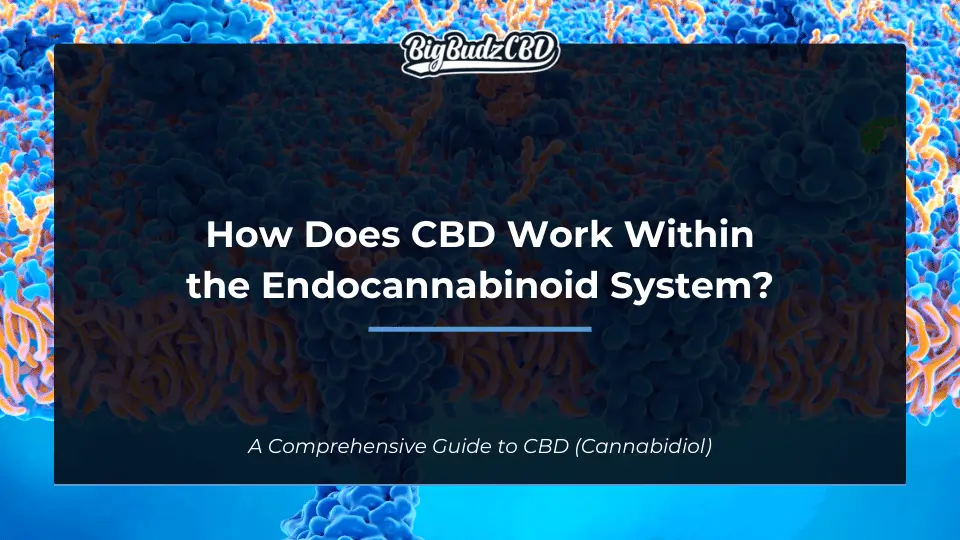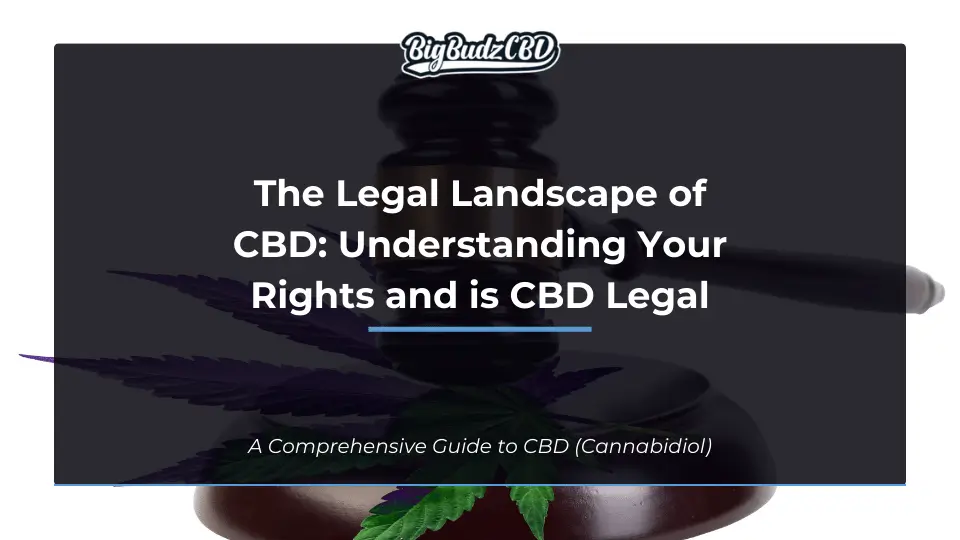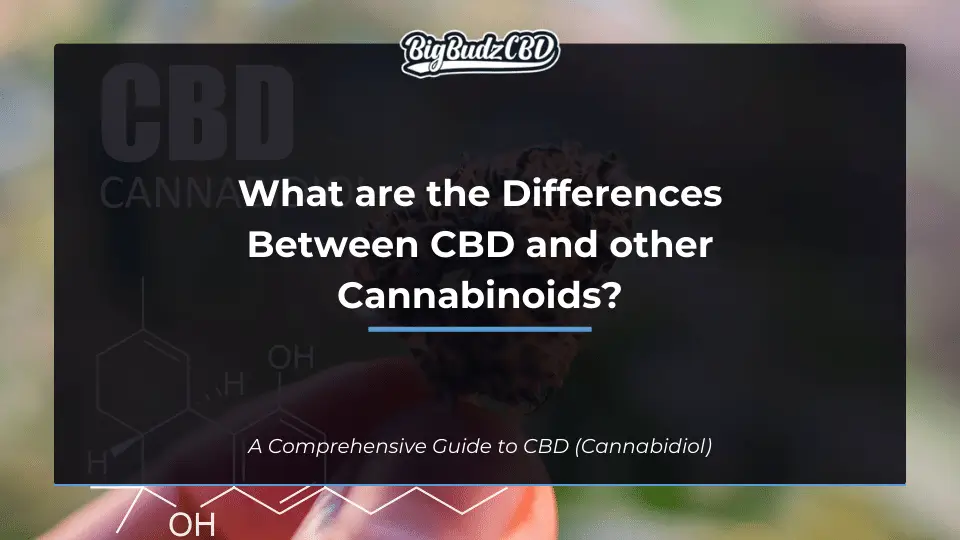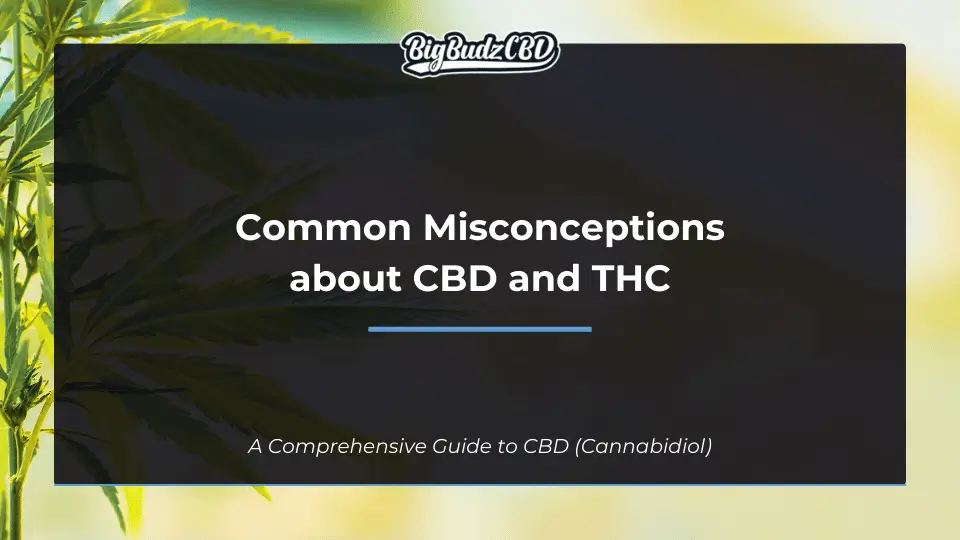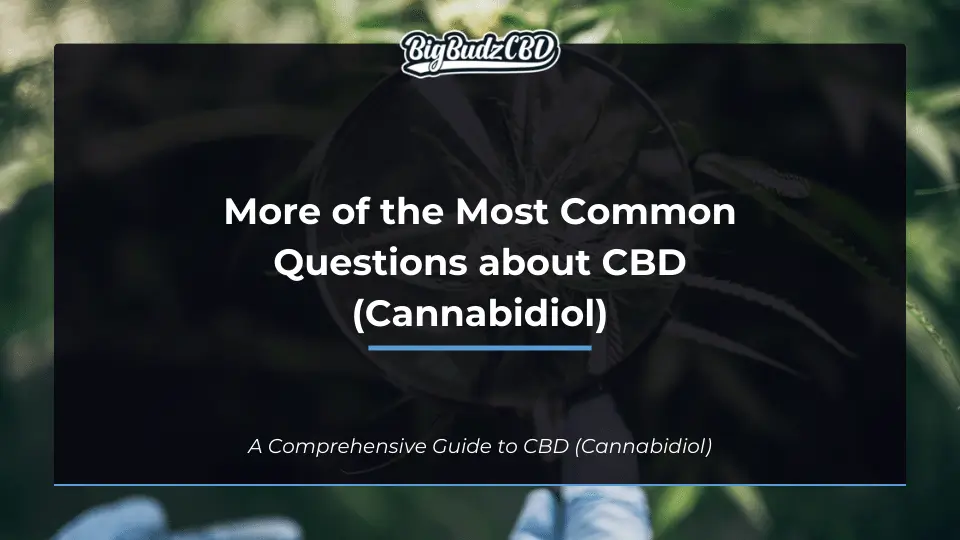CBD 101: The Ultimate Guide to All Things Cannabidiol, CBD Oil and Cannabinoids
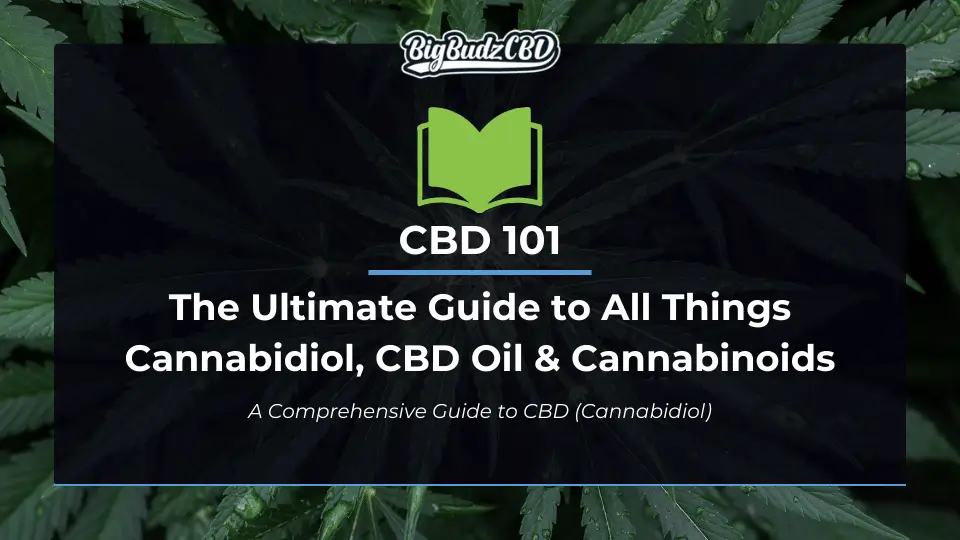
Whether you want to know what CBD is, how to use it, or how it compares to other cannabinoids, that’s exactly why we’ve created this resource for you.
Our goal is to provide you with tremendous value and answers that will help you improve your life and business with CBD.
On this page, we will be as thorough as possible to not miss anything related to the most common questions about the second most popular cannabinoid CBD (to that of THC).
What is CBD (Cannabidiol)?
CBD is one of over 100 cannabinoids found in the cannabis sativa plant.
Unlike the more well-known cannabinoid THC (tetrahydrocannabinol), CBD is not psychoactive and does not produce a “high” feeling.
It has been studied for its potential therapeutic benefits, including its ability to reduce pain, inflammation, anxiety, and seizures.
CBD is commonly used in various forms, such as oils, topicals, capsules, and edibles, and has gained popularity as a natural remedy for a wide range of conditions.
To expand a little more on “what is CBD…” it is a naturally occurring compound that comes from the cannabis plant and is mainly found in the resinous flower of cannabis (or hemp), a plant with a rich history as a medicine dating back thousands of years.
Today, the therapeutic properties of CBD are being tested and confirmed by scientists and doctors around the world.
A safe, non-addictive substance, CBD is one of more than a hundred “phytocannabinoids,” which are unique to cannabis and endow the plant with its robust therapeutic properties.
Why Listen to BigBudzCBD when it comes to CBD and Cannabinoids?
At BigBudzCBD we are very passionate about this compound and have developed a powerful line of products that simply work.
We now offer products like CBD hemp topicals, CBD vape pens, hemp CBD gummies, CBD flower products and much more!
We help people just like you overcome their struggles and pains so you can feel your best.
And if you’re looking for wholesale CBD products for your wellness shops, smoke shop or CBD store, we’ve got a selection of products that your customers will keep coming back for.
The Chemical Nature of CBD
At a molecular level, CBD is one of the most prevalent chemical compounds (cannabinoids) in the cannabis plant.
It’s a close chemical cousin to tetrahydrocannabinol (THC), the substance in cannabis that’s famous for causing a high, but unlike THC, CBD is not psychoactive.
This non-intoxicating characteristic makes CBD an appealing option for those looking for relief from various symptoms without the mind-altering effects of cannabis or certain pharmaceutical drugs.
Interaction with the Human Body
CBD and other cannabinoids interact with the human body through the endocannabinoid system (ECS).
The ECS is a complex cell-signaling system identified in the early 1990s by researchers exploring THC.
It’s involved in regulating a range of functions and processes, including sleep, mood, appetite, memory, reproduction, and fertility.
The body produces endocannabinoids, which are neurotransmitters that bind to cannabinoid receptors in your nervous system.
CBD influences the body to use its endocannabinoids more effectively.
It may activate or inhibit other compounds in the ECS.
For example, CBD stops the body from absorbing anandamide, a compound associated with regulating pain.
Increased levels of anandamide in the bloodstream may reduce the amount of pain a person feels.
So cannabinoids are designed to directly interact with all mammals, as we have an internal cannabinoid system (the ECS).
Types of CBD
What is CBD Isolate:
CBD isolate is the purest form of CBD, containing no other cannabinoids, terpenes, or flavonoids.
It’s usually extracted from hemp plants and contains no THC.
CBD isolate is a good option for those who want to try CBD but cannot or do not want to ingest any tetrahydrocannabinol (THC), which is still found in very small amounts in most broad-spectrum and full-spectrum products..
Most other CBD products contain at least an extremely low level of THC.
What is Broad-Spectrum CBD:
This type of CBD contains most cannabinoids, but it generally doesn’t include high levels of THC.
Broad-spectrum CBD is a good choice if you want to benefit from the wide array of cannabinoids but prefer to avoid THC due to its psychoactive effects or any other reason.
So if you’re not concerned about needing to take a drug-test for fear of it coming up positive, then broad-spectrum CBD is a great option.
What is Full-Spectrum CBD:
Full-spectrum CBD products contain all the compounds naturally found in the cannabis plant, including THC.
However, the THC content is supposed to be less than 0.3% in hemp-derived products, which isn’t enough to create a high.
Full-spectrum products provide the complete benefits of the cannabis plant, often referred to as the entourage effect.
This concept suggests that CBD and THC work better when taken together, as well as with the other cannabinoids, terpenes, and flavonoids found in cannabis.
CBD’s versatility and non-psychoactive nature have driven its popularity as a remedy for various conditions.
As research continues, it is likely that the vast array of benefits offered by CBD will become more thoroughly understood and documented.
Whether you’re interested in trying CBD for wellness, as a potential treatment for specific ailments, or chronic pain, or simply curious about its effects, understanding its origins, types, and interaction with your body is the first step towards making an informed decision.
If you’re thinking about giving CBD a go for your health, to help with certain issues, or just because you’re curious, the first thing you should do is learn about where it comes from, the different kinds, and how it works with your body and personal chemistry.
It’ll help you make a smart choice about whether to give it a try and choose from the variety of forms CBD comes in.
Always consult with a healthcare professional before starting any new supplement, especially if you have existing health conditions or are taking other medications.
What CBD Products Exist and How Can They Benefit Consumers?
There are many forms of cannabis.
The world of CBD is also vast and varied, with a multitude of products designed to suit different needs and preferences.
From oils to edibles, each type offers unique benefits and ways to consume CBD.
The thing about these products is that they all contain low levels of THC.
Here’s an overview of the most common types of CBD products available on the market.
CBD Oils
What are CBD Oils:
CBD oil is perhaps the most well-known and widespread form of CBD.
It’s made by extracting CBD from the cannabis plant and then diluting it with a carrier oil like coconut or hemp seed oil.
Uses and Benefits of CBD Oils:
CBD oil is known for its versatility.
It can be taken sublingually (placed under the tongue for a minute before swallowing), added to food or drinks, or applied topically.
It’s praised for its ease of use and the ability to customize dosage.
Users turn to CBD oil for a range of potential benefits, from relieving anxiety and pain to improving sleep and reducing inflammation.
CBD Tinctures
What are CBD Tinctures
Often confused with CBD oil, tinctures are also liquid extracts but are typically made with alcohol as the base.
They are usually found in dropper bottles and come in various flavors.
Uses and Benefit of CBD Tinctures:
Like oils, tinctures are taken sublingually and are known for their fast absorption.
They are a good option for those seeking quick effects and dose control.
Tinctures are commonly used for stress relief, sleep enhancement, and overall wellness.
CBD Edibles
What are CBD Edibles?
Edibles are food items infused with CBD.
They come in many forms, including gummies, chocolates, cookies, and beverages.
Uses and Benefits of CBD Edibles:
- CBD edibles are popular for their ease of use, discreet nature, and controlled dosage.
- They provide a longer-lasting effect as the CBD is released slowly during digestion.
- People often use edibles for sustained relief from symptoms like anxiety and chronic pain.
CBD Topicals
What is topical CBD?
These are creams, lotions, balms, and salves infused with CBD that are applied directly to the skin.
What are the Uses and Benefits of CBD Topicals:
- Topicals are ideal for targeting specific areas of the body.
- They are commonly used for localized pain relief, muscle soreness, and skin conditions or issues like rashes scratches, or bruising.
- Since they are applied externally, they don’t enter the bloodstream, making them a good choice for those solely interested in localized effects.
CBD Capsules
What are CBD Capsules?
- CBD capsules are a convenient way to take CBD in pill form.
- They contain a precise amount of CBD extract and typically have no taste.
- They are often made with cellulose capsules or soft gels.
Uses and Benefits of CBD Capsules:
- Capsules are favored for their convenience and consistency.
- They provide a simple way to incorporate CBD into a daily routine, similar to taking a multivitamin.
- Users opt for capsules to support overall health, manage stress, and maintain consistent sleep patterns.
CBD Vape Pens
What are CBD Vape Pens?
Vape pens are devices that heat a CBD-containing liquid to produce a vapor that’s inhaled.
What are the Uses and Benefits of CBD Vape Pens?
Vaping CBD offers the fastest absorption rate, meaning effects are felt almost immediately.
It’s a preferred method for those seeking quick relief from acute symptoms like sudden stress, anxiety attacks, or pain flare-ups.
Final thoughts on the many types of CBD products and how to use CBD
Each CBD product type offers distinct advantages and can cater to various preferences and needs.
Whether you prefer the direct and fast-acting effects of tinctures and vape pens or the convenience and sustained release of edibles and capsules, there’s a CBD product out there for you.
Understanding these options is the first step in making an informed decision about incorporating CBD into your lifestyle.
Always remember to start with lower doses, understand how your body reacts to CBD, and consult healthcare professionals if you’re taking other medications or have underlying health conditions.
Understanding the Benefits and Risks of CBD
Cannabidiol (CBD) has gained widespread attention for its potential to treat a variety of health conditions.
While research is ongoing and constantly evolving, some studies have suggested promising results.
However, it’s crucial to balance these potential benefits with an understanding of the possible risks and side effects.
Potential Health Benefits of CBD
- Anxiety and Depression: Numerous studies suggest that the use of pure CBD may help alleviate anxiety and depression. It’s thought to interact with the brain’s serotonin receptors, which regulate mood and social behavior. People have reported feeling less anxiety under CBD’s influence, and some clinical trials have supported its potential as a treatment for multiple anxiety disorders.
- Pain and Inflammation: CBD may offer an alternative for treating different types of chronic pain. It has been shown to reduce inflammation and pain in some studies, including those focused on arthritis and multiple sclerosis. This is believed to be due to CBD’s interaction with neurotransmitters and its anti-inflammatory effects.
- Neuroprotective Properties: Researchers believe that CBD’s ability to act on the endocannabinoid system and other brain-signaling systems may provide benefits for those with neurological disorders. Notably, it has been studied for its potential effectiveness in treating epilepsy and multiple sclerosis, with some positive findings.
- Heart Health: Some research has linked CBD with several benefits for the heart and circulatory system, including the ability to lower high blood pressure, which is linked to higher risks of several health conditions, including stroke, heart attack, and metabolic syndrome.
- Sleep Disorders: CBD has been used by some individuals to address issues with sleep, suggesting it might help with both falling asleep and staying asleep.
- Other Potential Benefits: CBD has been studied for its role in treating several other health issues, including antipsychotic effects on individuals with schizophrenia, substance abuse treatment, anti-tumor effects, and diabetes prevention.
Possible Risks and Side Effects of CBD
While CBD is generally considered safe, it can cause adverse reactions in some people. So is there a reason to avoid CBD?
CBD is generally well tolerated.
It’s likely not so much the actual cannabinoid CBD that has negative side effects, but the other compounds or ingredients you might find due to the extraction process or other ingredients in a formula.
The side effects noted in some studies of CBD include:
- Diarrhea
- Changes in Appetite and Weight
- Fatigue
- Dizziness
- Dry Mouth
- CBD, especially the purity of the CBD being taken into account, is also known to interact with several medications. If you’re taking any prescription medication, it’s important to consult with a healthcare professional before starting to use CBD.
Important Considerations when Dosing CBD
- Quality and Purity: The market is unregulated in many areas, leading to inconsistencies in product quality and CBD content. This lack of standardization can contribute to varying results and potential risks.
Research Limitations: Many studies and clinical trials have been relatively small or conducted primarily on animals. More extensive human studies are needed to substantiate the claims and understand the long-term effects and potential benefits of CBD.
Regulatory Status: The legal status and oversight of CBD products vary by region, affecting the research, production, and quality control of CBD products.
Last thoughts on CBD Benefits and Risks
CBD shows promise in potentially treating a wide range of health conditions.
Its potential benefits for anxiety, pain, neurodegenerative diseases, heart health, and more make it a subject of intense interest and ongoing research.
However, it’s equally important to consider the potential side effects and the quality of the CBD products being used.
As with any supplement or treatment, it’s crucial to weigh the potential benefits against the risks and consult healthcare professionals before starting new health regimens.
And just as important is the research and inquiry that needs to be done before purchasing a particular CBD product. Making sure the quality and integrity of the product is on point is vital.
If you care what the world health organization has to say about CBD here’s an article that will help.
As the body of research grows, our understanding of how best to utilize CBD for health and wellness will continue to evolve.
CBD Dosage Guide: Finding Your Optimal Dosage
Determining the right dosage of CBD can be a personal journey, as it varies greatly depending on individual factors and the reason for usage.
There is no one-size-fits-all dose, and finding the optimal amount often requires a thoughtful approach.
Here’s a guide to help you navigate the process of determining the right CBD dosage for your needs:
Understanding Dosage Variables
CBD for Body Weight:
Just like with many other substances, your body weight can influence how CBD affects you.
Generally, heavier individuals may require a higher dose to experience the same effects as someone lighter.
Condition Being Treated:
The optimal dosage can vary significantly based on what you’re using CBD for.
For instance, someone using CBD for chronic pain might need a higher dose than someone using it for mild anxiety or as a dietary supplement.
Product Potency:
The concentration of CBD in the product you’re using will greatly affect how much you should take.
Products vary widely in their potency, so always check the amount of CBD per serving on the label.
Starting Low and Going Slow
Initial Dosage:
It’s widely recommended to start with a small dose of CBD, especially if you’re new to it.
This might mean starting with 10 to 30 mg a day and gradually increasing by 5 mg after a week.
Monitor and Adjust:
Pay attention to how your body reacts.
If you don’t feel the desired effects after a week, increase your dose by a small amount.
Continue this process until you find the dose that gives you the desired effect.
Calculating Your Dosage
Standard Dosing:
Many sources suggest that a baseline dosage is important, considering levels of CBD found in hemp, and they recommend a dosage of 1 to 6 mg of CBD for every 10 pounds of body weight.
Dosage Calculators:
Some online resources and manufacturers offer dosage calculators based on your weight and the condition being treated.
Consultation with Health Professionals: If possible, consult with a doctor experienced in cannabis use.
They can provide personalized dosage recommendations based on your medical history and the specifics of what you’re treating.
Factors Affecting Dosage
Method of Delivery:
The way you consume CBD (e.g., oils, capsules, edibles, or vaping) affects its bioavailability and how quickly it starts working.
Inhalation provides a quicker onset but shorter duration, while edibles take longer to kick in but last longer.
Personal Chemistry:
Individual differences in metabolism, genetics, and ECS sensitivity can affect how you respond to CBD.
Consistency:
Regular use can influence how your body responds to CBD over time. Some people might find they need to adjust their dosage after prolonged use.
Safety and Side Effects
Safety Profile:
CBD is generally well-tolerated, but it can cause side effects like dry mouth, diarrhea, reduced appetite, drowsiness, and fatigue in some people.
Interactions:
CBD can interact with several medications, so it’s essential to consult a healthcare provider if you’re taking prescription drugs alongside CBD.
Finding your optimal CBD dosage is a personalized process influenced by various factors, including body weight, the condition being treated, and the product’s potency.
Starting with a low dose and gradually increasing it is the safest way to determine what works best for you.
Always consider product labels, seek advice from health professionals, and listen to your body’s response as you adjust your dosage.
With a thoughtful and informed approach, you can find the dosage that best meets your needs and enhances your well-being.
Recommended CBD Dosage Table (Consult a Doctor before Choosing your Dosage)
It’s important to note that the ideal dosage of CBD can vary widely depending on several factors like body weight, the condition being treated, the individual’s body chemistry, and the concentration of CBD in the product.
However, here’s a basic framework to start with:
| Body Weight | Mild Effects | Moderate Effects | Strong Effects |
|---|---|---|---|
| < 130 lbs | 10-15 mg | 15-20 mg | 20-25 mg |
| 130-230 lbs | 15-20 mg | 20-30 mg | 30-40 mg |
| > 230 lbs | 20-25 mg | 30-40 mg | 40-50 mg |
- Mild Effects: Typically for minor pain, mood enhancement, mild anxiety, and general health.
- Moderate Effects: For moderate pain, moderate anxiety, sleep disorders, and inflammation.
- Strong Effects: For severe pain, severe anxiety, severe insomnia, and other more acute conditions.
Important Considerations:
- Start Low and Go Slow: Begin with a lower dose and gradually increase until you find the effective dose for you.
- Consult a Healthcare Professional: Especially if you are taking other medications or have underlying health conditions.
- Quality of Product: Ensure you’re using a high-quality CBD product, as potency and purity can vary.
Remember, this table is a general guide and individual responses to CBD can vary. It’s always best to consult with a healthcare provider for personalized advice.
How Does CBD Work Within the Endocannabinoid System?
To understand how CBD (Cannabidiol) works within the endocannabinoid system (ECS), it’s essential first to grasp what these components are and their role in our bodies.
The Endocannabinoid System (ECS): A Quick Overview
The ECS is a complex cell-signaling system identified in the early 1990s by researchers exploring THC, the most well-known cannabinoid.
While experts are still trying to fully understand the ECS, it’s known to play a role in regulating a range of functions and processes, including sleep, mood, appetite, memory, reproduction, and fertility.
The role that CBD plays within the endocannabinoid system
The ECS involves three core components:
- Endocannabinoids: Small molecules that bind to receptors and are similar to cannabinoids but produced by your body.
- Receptors: Found throughout your body, endocannabinoids bind to them to signal that the ECS needs to take action.
- Enzymes: Break down endocannabinoids once they’ve carried out their function.
Enter CBD: CBD’s effects are more subtle and significantly influenced by its interaction with the ECS and they can help almost every system in the body.
CBD and ECS Receptors
The two main ECS receptors are CB1, predominantly in the central nervous system, and CB2, found mainly in your peripheral nervous system, especially immune cells.
CBD doesn’t bind to these receptors directly. Instead, it works indirectly by influencing your body to use more of its own endocannabinoids effectively.
For instance, it inhibits the FAAH enzyme, which breaks down anandamide, an endocannabinoid, thereby increasing its level in your body.
Interaction of Cannabinoids and Endocannabinoids in the Body
What are Cannabinoids exactly?
These are sticky resinous compounds found predominantly in the cannabis plant, but they are also present in a few other plants such as hops.
The most well-known cannabinoids are THC (Tetrahydrocannabinol) and CBD (Cannabidiol).
Each cannabinoid has different effects on the body, and their impact is primarily through their interaction with the ECS.
What are Endocannabinoids?
These are cannabinoids that our bodies produce naturally and have the ability to help support many functions within the body.
The two primary endocannabinoids are anandamide (AEA) and 2-arachidonoylglycerol (2-AG).
They help regulate functions like sleep, mood, appetite, and pain sensation and are released when the body signals a need for them.
Interestingly endocannabinoids are present within almost every major body system: the nervous system, immune system, musculoskeletal system, and the digestive system among others.
Interactions in the ECS
1. Receptor Binding:
CB1 receptors are primarily found in the brain and central nervous system
THC binds to these receptors and mimics the effects of anandamide, leading to the euphoria or “high” associated with cannabis.
However, endocannabinoids like anandamide also bind to these receptors, influencing feelings of well-being and the pain response.
CB2 receptors are found in the peripheral nervous system and immune cells.
Cannabinoids binding to these receptors are more involved in reducing inflammation and mediating the immune response.
CBD doesn’t bind strongly to CB1 or CB2 but influences other receptors and ion channels to exert its effects.
2. Modulation of Enzymes:
Enzymes like FAAH (fatty acid amide hydrolase) and MAGL (monoacylglycerol lipase) break down endocannabinoids.
Cannabinoids can inhibit these enzymes, thereby increasing or prolonging the action of endocannabinoids.
For example, CBD inhibits FAAH, which breaks down anandamide, thus potentially increasing anandamide levels and its positive effects.
3. Production and Release:
Endocannabinoids are produced on demand and released into the synapse.
They then bind to receptors on the neighboring cell (retrograde signaling) to modulate activities like neurotransmitter release.
Cannabinoids can influence the production and release of endocannabinoids, thereby indirectly affecting physiological processes.
4. Non-Cannabinoid Receptor Interactions:
Cannabinoids, especially CBD, interact with a variety of non-cannabinoid receptors and channels.
For example, CBD binds to serotonin receptors, which may explain its potential anti-anxiety effects.
It also interacts with TRPV1 receptors, involved in regulating pain, inflammation, and temperature.
The Entourage Effect
The entourage effect is a concept suggesting that cannabinoids have greater therapeutic potential when used together rather than in isolation.
It’s believed that when cannabinoids like CBD are combined with other plant compounds, including minor cannabinoids and terpenes, they can modulate each other’s effects.
For instance, CBD can mitigate the psychoactive effects of higher levels of THC while enhancing its therapeutic properties, and terpenes can increase cannabinoid absorption or bind to neurotransmitters themselves.
The interaction of cannabinoids and endocannabinoids within the body is a complex dance of chemistry and signaling that contributes to the ECS’s role in maintaining balance.
Understanding these interactions helps researchers and medical professionals harness the therapeutic potential of cannabinoids, offering more nuanced and effective treatments for a variety of conditions.
As research continues, the potential for more targeted therapies grows, painting a promising future for cannabinoid science.
The results of this will be the dispelling of the myths around problems associated with the use or cannabis and hemp.
How Cannabinoids like CBD and THC Differ
What’s the difference between CBD and THC?
CBD (Cannabidiol) and THC (Tetrahydrocannabinol) are both naturally occurring compounds found in cannabis plants, but they have different properties and effects:
Chemical Structure: Both CBD and THC have the same molecular structure: 21 carbon atoms, 30 hydrogen atoms, and 2 oxygen atoms. However, there is a slight difference in how these atoms are arranged, which accounts for their differing effects on the body.
Psychoactive Effects: THC is best known for its psychoactive effects—it’s the compound that makes people feel “high.” CBD, on the other hand, is non-psychoactive. It doesn’t cause a high but may produce other effects by interacting with different receptors in the body.
Medical Benefits: Both substances interact with the body’s endocannabinoid system but have different effects. CBD is studied for its potential role in easing symptoms of many common health issues, including anxiety, depression, acne, and heart disease. It’s also proven effective in treating some forms of epilepsy. THC has its own set of medical benefits, such as pain relief, and is commonly used to treat conditions like insomnia, low appetite, and glaucoma.
Legal Status: The legal status of THC and CBD varies by country and often by state within countries. Generally, THC is much more heavily regulated or illegal, while CBD might be available and legal, especially if it’s derived from hemp (which is a variety of the cannabis plant bred to be low in THC).
Side Effects: CBD is generally well-tolerated, though it can cause side effects such as fatigue, diarrhea, and changes in appetite or weight in some people. THC can cause temporary side effects such as increased heart rate, coordination problems, dry mouth, red eyes, slower reaction times, memory loss, and anxiety.
It’s important to note that the effects and legality of both CBD and THC can vary greatly depending on the jurisdiction and individual health conditions.
Medical advice should always be sought before using any form of cannabis for medical purposes.
Is CBD psychoactive or non-psychoactive?
CBD, or cannabidiol, is generally considered to be non-psychoactive, especially when compared to THC, the most well-known psychoactive cannabinoid found in cannabis.
This means that CBD doesn’t produce the “high” that’s typically associated with cannabis use.
However, describing CBD as non-psychoactive isn’t entirely accurate; a more precise term might be “non-intoxicating.”
CBD does affect the brain and can influence mood, which means it’s psychoactive to some degree.
For instance, many users report feeling calmer or more relaxed after taking CBD, which indicates an influence on the brain’s receptors involved in mood regulation.
The key difference is that while CBD can have a subtle impact on your mental state, it doesn’t cause the significant alteration in perception, mood, consciousness, or behavior that THC does.
Instead, CBD is valued for its potential therapeutic effects, such as reducing anxiety, pain, and inflammation without the psychoactive effects.
Does CBD show up on a Drug Test and can it Lead to Impairment?
CBD itself is unlikely to show up on a standard drug test.
Most drug tests are designed to detect specific substances, particularly THC (tetrahydrocannabinol), the psychoactive compound in cannabis.
Since CBD is a different compound with no psychoactive effects, it’s not usually something that drug tests look for.
However, there are a few caveats to consider:
Product Purity: Not all CBD products are created equal. Some may contain trace amounts of THC, especially if they are full-spectrum CBD products derived from cannabis rather than hemp. In the United States, hemp-derived CBD products are allowed to contain up to 0.3% THC by dry weight. While this amount is too small to produce a high, it might be enough to show up on a highly sensitive drug test if consumed in large quantities.
Mislabeling: The CBD market is still relatively unregulated, and studies have shown that some products don’t contain the amounts of CBD they claim, and some may contain more THC than stated. This mislabeling can inadvertently lead to the consumption of THC and a positive drug test result.
Body Metabolism: Individual differences in how bodies metabolize substances can affect how long THC or other cannabinoids remain detectable in the system.
As for impairment, CBD is generally considered non-intoxicating and is unlikely to impair cognitive or motor functions in the way that THC can.
Most users report that CBD makes them feel more relaxed or less anxious, but it doesn’t cause the altered perception, coordination issues, or memory impairment associated with THC.
That said, everyone’s body reacts differently to cannabinoids, and some people might experience side effects from CBD, such as drowsiness or changes in appetite or mood.
While these aren’t the same as the impairment associated with being high on THC, they could potentially affect your ability to perform tasks that require full attention or coordination.
As with any supplement or medication, it’s essential to start with a low dose to see how your body responds and to consult with a healthcare professional, especially if you’re taking other medications or have underlying health issues.
Exploring “Hemp Oil” vs. CBD oil: What gets detected?
Hemp oil and CBD oil are often confused, but they are quite different in their composition and the substances they contain, which affects what might get detected in a drug test.
What is Hemp Oil:
Also known as hemp seed oil, this is made from the seeds of the hemp plant. Hemp seeds do not contain CBD or THC and will never get you high, and will not make you fail a drug test.
Hemp oil is primarily used for its nutritional benefits as it’s rich in essential fatty acids and antioxidants.
Since it doesn’t contain CBD or THC, using hemp oil won’t cause you to fail a drug test.
What is CBD Oil:
This is made from the flowers, leaves, and stalks of the hemp plant, which contain a higher concentration of CBD, other cannabinoids, and terpenes.
CBD oil can vary greatly in the amount and ratio of cannabinoids depending on whether it’s a full-spectrum, broad-spectrum, or isolate product:
- Full-spectrum CBD Oil: Contains all cannabinoids found in the cannabis plant, including THC (though federally legal products will have less than 0.3% THC).
- Broad-spectrum CBD Oil: Contains most cannabinoids, but THC is usually removed.
- CBD Isolate: Pure CBD with all other cannabinoids and compounds removed.
In the context of drug testing:
- Hemp Oil: Will not be detected since it contains no CBD or THC.
- CBD Oil:
- Full-spectrum: This might lead to a positive test for THC, especially with high consumption or very sensitive tests, due to the trace amounts of THC.
- Broad-spectrum and Isolate: Unlikely to show THC; however, the purity and accuracy of labeling can affect this.
No standard drug test will specifically look for CBD since it’s non-intoxicating.
However, the THC potentially present in some CBD products is what might be detected.
Always ensure you’re purchasing products from reputable sources (like BigBudzCBD) with clear, accurate labeling and third-party testing to minimize the risk of unexpected THC consumption and a positive drug test result.
If you are concerned about drug testing, consider using a pure CBD isolate or avoiding cannabinoid products altogether.
How concentrations of CBD can Influence Tests
The concentration of CBD in a product can indirectly influence drug test results, primarily due to the presence of THC, which is the primary psychoactive compound in cannabis that most drug tests are designed to detect.
Here’s how different concentrations might play a role:
High Concentration CBD Products: If you’re using a high-concentration full-spectrum CBD product, even the small percentage of THC (less than 0.3% in legal hemp products) can accumulate in your body over time. Frequent use of such products might lead to a build-up of THC in your system, increasing the chances of a positive drug test, especially if the test is highly sensitive.
Pure CBD Isolates: These products are supposed to contain only CBD and no other cannabinoids. In theory, using pure CBD isolate should not cause a positive drug test for THC. However, the purity depends on the manufacturing process and the integrity of the producer. Contamination with THC can occur, and mislabeling is a known issue in the industry.
Variable Product Quality and Labeling: The market is still relatively unregulated, and discrepancies between the actual cannabinoid content and what’s listed on the label are not uncommon. A product claiming to be THC-free or a pure isolate might still contain trace amounts of THC. Similarly, a product might have a higher or lower concentration of cannabinoids than advertised.
Body Metabolism and Fat Cells: THC is fat-soluble and can be stored in your body’s fat cells for a considerable time. The more frequently you use a product with THC, even in trace amounts, the more likely it is to build up in your system. Factors like your metabolism, body fat percentage, and how much and how often you use CBD products can all influence this.
Sensitivity of the Test: Some tests are more sensitive than others and can detect smaller amounts of substances. A highly sensitive test might pick up trace amounts of THC in someone who uses large quantities of CBD products regularly, even if those products are labeled as having no THC.
In summary, while pure CBD itself should not cause a positive result for THC on a drug test, the variable nature of product purity, labeling accuracy, individual body factors, and the sensitivity of the test can all influence the outcome.
If you have concerns about drug testing, you might opt for CBD isolates, though ensuring they come from a reputable source with third-party testing is crucial.
Alternatively, discussing your CBD use with your employer or the testing entity can provide guidance tailored to your specific situation.
Understanding why Pure CBD is generally well-tolerated
Pure CBD is generally well-tolerated by most people, and this is attributed to several factors related to its properties, how it interacts with the body, and its relatively mild side effect profile:
1. Endocannabinoid System (ECS) Interaction: CBD interacts with the body’s endocannabinoid system (ECS), a complex network of receptors and neurotransmitters that plays a crucial role in maintaining balance and regulating various physiological processes like mood, pain sensation, appetite, and sleep.
Unlike THC, which binds directly to cannabinoid receptors (CB1 and CB2), CBD has a more indirect influence. It modulates and enhances the endocannabinoid system’s functionality without overwhelming it, leading to a balanced and generally well-tolerated effect.
2. Non-Intoxicating: CBD does not produce the “high” that is typically associated with cannabis. This is because it doesn’t bind directly to the primary cannabinoid receptors in the brain that are responsible for psychoactive effects. The non-intoxicating nature of CBD makes it a preferred choice for those seeking the potential therapeutic benefits of cannabinoids without the psychoactive side effects.
3. Side Effect Profile: For most people, CBD has a relatively mild side effect profile, especially at moderate doses. Common side effects might include tiredness, changes in appetite, or gastrointestinal issues, but these are typically mild and not experienced by everyone. This favorable side effect profile contributes to its reputation as being well-tolerated.
4. Lack of Dependency and Tolerance: Unlike many conventional drugs, particularly those used for pain and mood disorders, CBD does not seem to lead to dependency or tolerance. This means users are unlikely to need to increase their dose continually to achieve the same effect, and they’re at a lower risk of experiencing withdrawal symptoms if they stop taking it.
5. Therapeutic Potential: CBD has been studied for various potential therapeutic benefits, including anti-inflammatory, analgesic, anxiolytic, and anticonvulsant properties. The wide range of potential benefits without the psychoactive effects makes it an attractive option for individuals looking for natural alternatives.
6. Regulatory Status: Especially in countries or states where CBD is legal and regulated, products undergo testing for purity and consistency, ensuring they’re free from contaminants like pesticides, heavy metals, and excessive levels of THC. This regulatory oversight helps maintain a standard of safety and quality.
While CBD is generally well-tolerated, it’s essential to note that individual experiences can vary, and CBD can interact with certain medications.
Therefore, it’s always recommended to consult with a healthcare professional before starting any new supplement, including CBD, particularly if you have underlying health conditions or are taking other medications.
The Legal Landscape of CBD: Understanding Your Rights and is CBD Legal
The legal status of CBD is complex and varies significantly around the world and even within regions of the same country.
This overview provides a general understanding of the legal considerations surrounding CBD globally, regionally, and the nuances of traveling with CBD, age restrictions, and purchasing guidelines.
Global CBD Legal Status
Worldwide Overview:
Internationally, the CBD legal status varies dramatically.
Some countries have fully legalized CBD for medical and recreational use, while others have strict regulations or outright bans.
The key factor often lies in the distinction between marijuana-derived CBD and hemp-derived CBD, with the latter typically facing less strict regulations due to its low THC content.
United States:
In the U.S., the 2018 Farm Bill legalized hemp-derived CBD at the federal level, provided it contains less than 0.3% THC.
However, state laws vary greatly. Some states have embraced CBD fully, while others have specific restrictions or have not legalized it at all.
European Union:
Most EU countries allow the sale and consumption of CBD products derived from hemp with THC content below 0.2%.
However, individual countries may have their own regulations, so it’s crucial to check the specifics for each nation.
Canada:
Canada legalized cannabis, including CBD, in 2018. However, the market is highly regulated, and products must be purchased through authorized retailers.
Asia, Africa, and the Middle East:
These regions have some of the strictest cannabis laws in the world. Many countries do not differentiate between hemp and marijuana, making CBD illegal or heavily regulated.
Traveling with CBD
Navigating Borders:
When traveling with CBD, it’s crucial to research the laws of both the departure and destination countries.
Even in places where CBD is legal, carrying it across borders can be problematic.
For air travel, particularly international flights, the safest approach is to check the regulations of the airline and the specific countries involved.
Age Restrictions
Purchasing and Consumption: Legal age requirements for purchasing and consuming CBD products typically align with local laws for tobacco or alcohol.
Most places that regulate CBD sales impose an age limit of 18 or 21.
Purchasing Guidelines
Quality and Compliance: When purchasing CBD, look for products from reputable sources that provide third-party lab testing results to ensure quality and compliance with local laws.
This testing should confirm the THC content and the purity of the product, ensuring it’s free from contaminants like pesticides and heavy metals.
Can Quality CBD Products Be Differentiated Legally and Ethically?
Yes, quality CBD products can be differentiated legally and ethically in several ways.
This differentiation is crucial for consumers seeking safe and effective products, as well as for businesses aiming to maintain credibility and trust in the market.
Here’s how legal and ethical considerations come into play:
Legal Differentiation
Regulatory Compliance:
In regions where CBD is legal, products must comply with specific regulations concerning their production, labeling, and THC content.
Legally differentiated products will adhere to these regulations, ensuring they are safe and legal to sell and consume.
THC Content:
Legally, CBD products must contain less than a certain percentage of THC (usually 0.2% or 0.3%, depending on the jurisdiction).
Products that comply with this threshold are legal in jurisdictions with such laws.
Licensing and Approval:
In some areas, CBD products might need to be licensed or approved by a government or regulatory body.
Legitimate products will have the necessary approvals, indicating compliance with legal standards.
Age Restrictions:
Legal CBD products are often subject to age restrictions. Ethical sellers will enforce these age limits to ensure they’re not selling to underage consumers.
Ethical Differentiation
Transparency:
Ethical CBD producers and retailers provide full transparency about the source of their hemp, the extraction method, and the product’s ingredients.
They’ll openly share third-party lab test results to confirm the product’s CBD and THC content, as well as its purity from contaminants.
Quality Control:
Ethical companies invest in high-quality extraction methods and rigorous quality control processes to ensure their products are safe and effective. They’ll often use organic, non-GMO hemp and avoid harmful additives.
Accurate Labeling:
Ethically produced CBD products will have accurate, clear, and informative labels.
They’ll include information about the CBD content, dosage recommendations, ingredients, and suggested use.
Education and Claims:
Ethical CBD companies focus on educating consumers rather than making unfounded or exaggerated health claims.
They’ll provide resources to help users understand CBD’s effects, benefits, and limitations.
Sustainable and Responsible Practices: Ethically-minded companies also consider the environmental and social impact of their production.
This might include using sustainable farming practices, ensuring fair labor conditions, and engaging in community initiatives.
Consumer Role
As a consumer, you can differentiate quality CBD products legally and ethically by:
Researching Brands:
- Look into the brand’s reputation, reviews, and history.
- Trustworthy brands are typically transparent about their processes and products.
Checking for Lab Reports:
Always check for third-party lab reports, also known as Certificates of Analysis (COA), which verify the product’s CBD and THC content and purity.
Understanding the Laws:
Be aware of the CBD laws and regulations in your area to ensure you’re purchasing and using CBD legally.
Seeking Professional Advice:
- If unsure, consult with healthcare professionals, especially if you’re considering CBD for therapeutic purposes.
- In summary, differentiating quality CBD products legally and ethically involves a combination of regulatory compliance, transparency, quality control, and consumer education.
- As the market continues to grow and evolve, these considerations will remain crucial for ensuring safety and efficacy.
Lastly, on the Legality of CBD
The legal landscape of CBD is constantly evolving, with laws differing widely from one place to another.
Before purchasing, possessing, or traveling with CBD, it’s essential to research and understand the specific laws applicable to your location and any destinations you plan to visit.
Always prioritize buying from reputable sources that provide transparent product information and lab reports.
As the global conversation around cannabis and CBD continues to evolve, staying informed is crucial for anyone interested in using CBD products legally and safely.
Difference between “hemp oil”, CBD oil, and hemp-derived CBD
The terms “hemp oil”, “CBD oil”, and “hemp-derived CBD” are often used interchangeably, but they refer to different products with distinct characteristics and uses.
Hemp Oil (Hemp Seed Oil):
- Source: Hemp oil is extracted from the seeds of the hemp plant, Cannabis sativa. It’s important to note that hemp seeds do not contain CBD or THC.
- Composition: It’s primarily composed of dietary fats and has a high concentration of omega-3 and omega-6 fatty acids, gamma-linolenic acid, and other nutritional antioxidants. It also contains vitamins and minerals.
- Uses: Hemp oil is mostly used in food and skincare products. In culinary applications, it can be used as a cooking oil or added to foods. In skincare, it’s prized for its moisturizing and non-comedogenic properties.
- Legal Status: Widely legal and not regulated by laws concerning cannabis.
CBD Oil:
- Source: CBD oil is made by extracting cannabidiol (CBD) from the cannabis plant and then diluting it with a carrier oil like coconut oil or hemp seed oil. It can be sourced from either hemp or marijuana plants; however, when it’s sourced from hemp and contains less than 0.3% THC, it’s generally considered legal in places where hemp is legal.
- Composition: CBD is one of over a hundred cannabinoids found in cannabis. The oil usually contains a higher concentration of CBD and may contain varying levels of other cannabinoids, terpenes, and flavonoids, depending on the extraction process and plant.
- Uses: CBD oil is used for its potential therapeutic effects. It’s thought to interact with the body’s endocannabinoid system and may help with anxiety, pain, sleep, and inflammation, although more research is needed to fully understand its effects and efficacy.
- Legal Status: Its legality can vary depending on the source (hemp vs. marijuana) and the local laws related to cannabis and hemp.
Hemp-Derived CBD:
- Source: This is a specific type of CBD oil that is extracted exclusively from the hemp plant, which is a variety of Cannabis sativa that contains very low levels (less than 0.3%) of THC.
- Composition: Similar to CBD oil, it contains CBD as the primary active ingredient, but by definition, it will always have less than 0.3% THC.
- Uses: The uses are similar to general CBD oil and include wellness and therapeutic applications.
- Legal Status: In places where hemp-derived products are legal, hemp-derived CBD typically enjoys the same status, making it more widely legal and accessible than CBD derived from marijuana.
When choosing a product, it’s important to look at the labels and lab reports for specifics about their cannabinoid content and to ensure they’re tested for purity and safety. Also, consider the legal status of these products in your region, as it can vary significantly.
Quality checks for CBD products: Purity and concentrations
Ensuring the quality of CBD products is crucial for both safety and effectiveness.
High-quality CBD products should go through rigorous testing to verify their purity and concentrations.
This ensures that the product is free from contaminants like heavy metals, pesticides, and molds, and that it contains the stated amount of CBD and other cannabinoids.
Quality Checks for CBD Products: Purity and Concentrations
Third-Party Lab Testing: Reputable CBD products are often accompanied by a Certificate of Analysis (CoA) from an independent lab. This document verifies the product’s cannabinoid profile and checks for the presence of contaminants.
Source of Hemp: High-quality CBD products are derived from hemp that is grown organically and responsibly, ensuring that the end product is free from harmful chemicals and pesticides.
Extraction Method: The method used to extract CBD from hemp plants can affect its quality. CO2 extraction is widely regarded as a safe and efficient method that maintains the purity of the CBD.
Cannabinoid Profile: A detailed profile of cannabinoids present in the product, including CBD and THC levels, is crucial. Products with a full or broad-spectrum profile may offer additional benefits due to the entourage effect.
Check for Additives: Quality CBD products should be free from unnecessary additives, artificial colors, or flavors that can compromise the product’s purity.
Batch Consistency: Reliable manufacturers ensure that each batch of products maintains consistent quality and potency, which is usually verified through batch-specific testing.
Regulatory Compliance: Ensure that the product meets the legal requirements for sale and consumption in your region, which typically involves limits on amounts of THC content and other regulations.
Before purchasing any CBD product, it’s important to conduct research, read reviews, and, if possible, consult with a healthcare professional.
Quality is paramount not just for achieving the desired effects but also for ensuring your safety and well-being.
How to Avoid Subpar CBD Products
Avoiding subpar CBD products is essential for ensuring that you receive the potential benefits of CBD without any unwanted side effects or contaminants.
Here are some strategies to help you identify and avoid low-quality CBD products:
Look for Certificates of Analysis (CoA):
- Third-Party Testing: Only buy products that have been tested by independent third-party labs. These labs verify the product’s cannabinoid content and check for contaminants.
- Comprehensive Reports: Ensure the CoA includes information on potency, cannabinoid profile, and tests for presence of heavy metals, pesticides, and solvents.
Understand the Source:
- Organic Hemp: Look for CBD derived from organically grown hemp, as this reduces the likelihood of pesticide and chemical contamination.
- Reputable Source: Choose brands that are transparent about their hemp sourcing and cultivation practices.
Examine the Extraction Method:
- CO2 Extraction: Products made using CO2 extraction are often purer and cleaner, as this method doesn’t leave behind harmful solvents.
Read the Label Carefully:
- Clear Information: The label should clearly state the amount of CBD per serving, the total CBD content, and the type of CBD used (isolate, broad-spectrum, full-spectrum).
- Ingredients List: Check for any harmful additives or substances you may be allergic to.
Avoid Unrealistic Claims:
- Medical Claims: Be wary of products that claim to cure or treat diseases. Legitimate CBD products won’t make unproven health claims.
- Overly Cheap Products: If the price seems too good to be true, it probably is. Quality CBD often comes at a cost due to the extensive process of cultivation and extraction.
Check for Legal Compliance:
- THC Content: Ensure the product complies with the legal THC limit in your area (typically less than 0.3% THC).
- Regulatory Approvals: Some regions have specific regulations and approvals for CBD products. Make sure the product you’re buying meets these standards.
Research the Brand:
- Brand Reputation: Look for reviews and user testimonials about the brand and its products. Established brands with positive feedback are generally more reliable.
- Transparency: Good brands provide detailed information about their production process, hemp source, and lab results.
Consult with Professionals:
- Healthcare Advice: If possible, discuss with a healthcare professional experienced in CBD use. They can provide advice tailored to your health needs and help you identify reputable products.
By being diligent and informed, you can significantly reduce the risk of buying subpar CBD products and ensure that you’re investing in a product that is safe, effective, and suited to your needs.
What are the Differences Between CBD and other Cannabinoids?
Understanding CBD vs. THC
CBD (Cannabidiol) and THC (Tetrahydrocannabinol) are both cannabinoids, natural compounds found in cannabis plants.
Despite their similar chemical structures, they have different properties and effects on the body, primarily because they interact differently with the endocannabinoid system (ECS).
Understanding these differences is crucial for recognizing how each might affect you.
Psychoactive Effects:
- THC: It’s the main psychoactive component of cannabis, meaning it’s responsible for the ‘high’ associated with marijuana use. THC binds directly to CB1 receptors in the brain and alters brain function, leading to changes in perception, mood, consciousness, and behavior.
- CBD: It’s considered non-intoxicating. It doesn’t produce a ‘high’ and has a more indirect effect on the ECS. While CBD can influence mood and perception, it does so in a way that can reduce anxiety and improve a sense of well-being without the intoxicating effects of THC.
Medical Benefits:
- THC: It’s known for its pain-relieving properties and is often used to treat pain, muscle spasticity, glaucoma, insomnia, low appetite, nausea, and anxiety. However, it can also produce unwanted side effects like increased heart rate, coordination problems, dry mouth, red eyes, slower reaction times, and memory loss.
- CBD: It’s recognized for its potential therapeutic effects, including anti-inflammatory, analgesic (pain relief), anti-anxiety, and anticonvulsant properties. It’s being studied for various conditions, including anxiety disorders, chronic pain, epilepsy, PTSD, and more. CBD is generally well-tolerated and doesn’t produce the side effects associated with THC.
Legal Status:
- THC: In many places, THC is still illegal or only legal for medical use under certain conditions because of its psychoactive effects and potential for abuse.
- CBD: It’s legal in more areas compared to THC, especially when derived from hemp (which is cannabis with a THC content of 0.3% or less). The legal status of CBD can still vary, so it’s essential to check local laws.
Drug Testing:
- THC: It’s the primary target in standard drug tests. Using products with THC can result in a positive drug test, which can have legal, employment, or personal consequences.
- CBD: Pure CBD shouldn’t show up on a standard drug test, but as many CBD products contain trace amounts of THC, there’s a risk of a positive test depending on the sensitivity of the test and the amount of CBD/THC consumed.
Interaction with Other Medications: Both CBD and THC can interact with other medications you’re taking.
For instance, they can affect liver enzymes and either increase or decrease the levels of other drugs in your blood, potentially leading to adverse effects or reduced effectiveness of your medications.
Personal Experience: Finally, it’s worth noting that everyone’s body chemistry is different. How you might respond to CBD or THC can vary based on your genetics, underlying health conditions, and other factors.
It’s always wise to start with a low dose and consult healthcare professionals, especially if you’re considering using them for therapeutic purposes.
In summary, while CBD and THC have similarities as cannabinoids, their differences in psychoactivity, legal status, and health effects are significant.
Understanding these can help you make informed decisions about whether and how to incorporate them into your life.
CBD and Hemp: A closer look
CBD (Cannabidiol) and hemp are closely related but distinct in terms of their composition, uses, and legal status.
Understanding their relationship and differences is crucial for consumers and those interested in the therapeutic potential of cannabinoids.
Key Differences and Relationship:
CBD Content:
- Hemp plants are specifically bred to produce high levels of CBD and minimal levels (less than 0.3%) of THC. This makes them the primary source for commercial CBD products.
- Marijuana plants can also produce CBD, but they are typically bred for high THC content and might have a wide range of THC to CBD ratios.
Legal Status:
- Hemp: In many places, hemp is legal to grow, sell, and use because it contains minimal amounts of THC. For instance, in the United States, the 2018 Farm Bill removed hemp (defined as cannabis with less than 0.3% THC) from the Controlled Substances Act.
- CBD: The legal status of CBD can be more complicated and often depends on how it’s derived. CBD from hemp is legal in many areas, but CBD from marijuana may fall under stricter regulations.
Uses:
- Hemp: Beyond CBD, hemp has a wide range of uses. Its seeds are high in protein, fiber, and healthy fatty acids, including omega-3s and omega-6s. The fibers from the stalk can be used to make textiles, paper, and construction materials.
- CBD: It’s primarily used for its potential health benefits. It’s available in various forms, including oils, tinctures, capsules, edibles, topical creams, and vapes.
Extraction and Products:
- CBD is extracted from the cannabis plant, typically the hemp variety due to its high CBD and low THC content. The extracted CBD can then be processed into various products.
- Hemp oil or hemp seed oil is another popular product derived from hemp. However, it’s made from the seeds of the plant and doesn’t contain significant amounts of CBD or THC. It’s valued for its nutritional content.
Conclusion:
While CBD and hemp are related (with CBD often being derived from hemp plants), they serve different purposes and have distinct legal and cultural implications.
Hemp is a versatile plant used for thousands of years for various applications, and is a variety of the cannabis sativa, while CBD is a relatively newly recognized compound valued for its potential therapeutic benefits.
As the legal landscape and scientific understanding of these substances continue to evolve, their roles in society and healthcare may expand further.
Common Misconceptions about CBD and THC
There are several misconceptions surrounding CBD and THC due to their association with cannabis, legal status, and how they affect the body. Here are some common ones:
1. All Cannabis Products Get You High:
- Misconception: Many people believe that using any cannabis-derived product will result in a psychoactive high.
- Reality: While THC is psychoactive and can produce a high, CBD does not. Hemp-derived CBD products (with less than 0.3% THC) are designed to provide potential health benefits without the high.
2. CBD and THC Have No Medical Benefits:
- Misconception: Some people think that CBD and THC are only used recreationally and have no real medical benefits.
- Reality: Both compounds have been studied for their potential therapeutic effects. THC is known for its pain-relieving properties and is used in medical marijuana. CBD has been studied for various potential benefits, including reducing anxiety, pain, and inflammation. The FDA has even approved a CBD-based drug called Epidiolex for certain types of seizures.
3. CBD is Completely Legal Everywhere:
- Misconception: There’s a common belief that CBD is legal in all parts of the world because it’s not psychoactive.
- Reality: The legality of CBD varies by jurisdiction. In the United States, for example, CBD derived from hemp with less than 0.3% THC is federally legal, but state laws vary. In other countries, the rules can be much stricter.
4. More THC or CBD is Always Better:
- Misconception: Some believe that higher doses of THC or CBD are always more effective.
- Reality: Both substances have a bell-shaped dose-response curve; they may be effective up to a point, but beyond that, additional amounts might not increase efficacy and could even cause adverse effects. The most effective dose varies from person to person and depends on the condition being treated.
5. CBD Has No Side Effects:
- Misconception: As a natural supplement, many assume CBD has no side effects.
- Reality: While CBD is generally well-tolerated, it can cause side effects in some people, such as dry mouth, diarrhea, reduced appetite, drowsiness, and fatigue. It can also interact with other medications.
6. All CBD Products are the Same:
- Misconception: People often think one CBD product is much like another.
- Reality: There’s a significant variance in the quality, purity, and concentration of CBD products due to differences in manufacturing processes, extraction methods, and the source of the cannabis. It’s essential to purchase from reputable sources that provide third-party testing.
7. THC is Bad, and CBD is Good:
- Misconception: There’s a tendency to demonize THC while glorifying CBD.
- Reality: Both THC and CBD have potential benefits and drawbacks. THC can be beneficial for certain medical conditions but also has psychoactive effects and potential for abuse. CBD is non-psychoactive and has a good safety profile but is not a cure-all and works best for certain conditions.
8. You Can’t Get Addicted to CBD or THC:
- Misconception: Because they’re natural, some believe you can’t develop a dependence on CBD or THC.
- Reality: While CBD has not been shown to have addictive properties and is generally considered non-habit forming, THC can be addictive for some people, leading to cannabis use disorder.
Understanding these nuances is critical in making informed decisions about using CBD, THC, or any cannabis-derived product. Consulting healthcare professionals and relying on scientific evidence is crucial, especially when considering these substances for therapeutic use.
How Variations in CBD and THC Levels Alter Effects
The variations in CBD and THC levels significantly influence the effects that cannabis products have on the body.
These two primary cannabinoids interact with the endocannabinoid system but in markedly different ways, and their ratios and concentrations can alter the experience, efficacy, and safety of their use.
Here’s how variations in CBD and THC levels can alter effects:
THC (Tetrahydrocannabinol):
Low Levels of THC:
- May provide a mild and more manageable euphoria or relaxation.
- Can be suitable for individuals new to cannabis or those with lower tolerance.
- May reduce stress and anxiety in some individuals without intense psychoactive effects.
High Levels of THC:
- Can produce strong psychoactive effects, including altered perception, euphoria, and impaired motor skills.
- May lead to more significant pain relief and appetite stimulation.
- Higher risk of negative side effects, including anxiety, paranoia, and short-term memory impairment.
THC Dominant Strains:
- Typically used for recreational purposes to achieve a “high.”
- Often chosen by individuals seeking relief from pain, insomnia, or lack of appetite.
- The effects can vary significantly depending on the individual’s biology and the specific strain’s terpene profile.
CBD (Cannabidiol):
Low Levels of CBD:
- May not provide the full therapeutic potential of CBD.
- In products with high THC and low CBD, the absence of significant CBD might lead to more pronounced psychoactive effects of THC.
High Levels of CBD:
- Known for its calming and anti-inflammatory properties.
- Can counteract some of the psychoactive effects of THC, leading to a more balanced and less intense experience.
- May help with a variety of conditions, including anxiety, chronic pain, epilepsy, and more.
CBD Dominant Strains:
- Often chosen for potential health benefits without the psychoactive effects.
- May help users remain clear-headed while experiencing relief.
- Can be particularly beneficial for daytime use or for those who want to avoid the high associated with THC.
Personal Variation:
- It’s also crucial to note that individual responses to THC and CBD can vary greatly due to factors like genetics, previous usage, individual biochemistry, and the specific condition being treated.
- What might be a relaxing dose for one person could be overwhelming or underwhelming for another.
Conclusion:
Understanding the variations in CBD and THC levels is essential for tailoring the cannabis experience to individual needs and preferences.
Whether seeking relief from specific symptoms or looking for a particular experience, users should consider these variations and start with lower doses, gradually adjusting as they become familiar with their responses.
Consulting healthcare professionals is also advisable, especially for those using cannabis for therapeutic purposes.
More of the Most Common Questions about CBD (Cannabidiol)
The role of cannabis and endocannabinoids in CBD products
Cannabis and endocannabinoids play a central role in the effects of CBD products through their interaction with the body’s endocannabinoid system (ECS).
The ECS is a complex cell-signaling system identified in the early 1990s by researchers exploring THC, a well-known cannabinoid from the cannabis plant.
It’s involved in regulating a range of functions and processes, including sleep, mood, appetite, memory, reproduction, and pain sensation.
Role of Cannabis:
Phytocannabinoids: Cannabis contains compounds called phytocannabinoids, the most notable being THC and CBD. These plant-based cannabinoids can interact with the human ECS in ways similar to the body’s own endocannabinoids.
Interaction with ECS: THC binds directly to cannabinoid receptors (CB1 and CB2), primarily affecting the central nervous system and the brain, which results in the “high.” CBD, on the other hand, has a more complex interaction. It doesn’t bind as directly with cannabinoid receptors but influences them and other types of receptors, enhancing the overall activity of the ECS.
Role of Endocannabinoids in CBD Products:
Modulation of ECS: CBD is thought to prevent the breakdown of endocannabinoids, which might allow them to have more of an effect on your body. It may also bind to a receptor that hasn’t been discovered yet.
Indirect Effects: While CBD doesn’t bind strongly to CB1 and CB2 receptors, its presence can influence the ECS indirectly. It’s believed to enhance the effects of other molecules in the ECS by improving the receptors’ ability to bind to cannabinoids, as well as having other effects on various receptor-independent pathways.
Therapeutic Implications:
The interaction of CBD with the ECS, and its ability to influence receptors outside of the endocannabinoid system, is believed to contribute to its potential therapeutic properties. Research suggests CBD may help with pain, nausea, and other symptoms associated with multiple conditions.
The theory of the entourage effect suggests that CBD works better when it’s consumed along with other cannabis compounds rather than as an isolate. This is because all the components of cannabis (including minor cannabinoids, terpenes, and flavonoids) can interact synergistically with the body’s ECS, enhancing the overall effects.
Conclusion:
The role of cannabis and endocannabinoids in CBD products is fundamentally about interaction with the ECS.
CBD, through its complex and not fully understood interaction with the ECS, has the potential to influence a wide array of bodily functions and potentially offer therapeutic benefits.
However, the exact mechanisms of action, optimal dosages, and full scope of effects require further research.
Always consult with healthcare professionals before starting any new supplement regimen, especially if you have underlying health conditions or are taking other medications.
Is there a time when you should avoid CBD?
While CBD is generally considered safe and well-tolerated, there are certain situations where you might want to avoid it or use it with caution.
As with any supplement or medication, it’s essential to consider individual circumstances, including health conditions, medications, and specific health goals.
Here are some situations where you should be cautious with CBD:
Pregnancy and Breastfeeding: There’s not enough research to confirm that CBD is safe during pregnancy or while breastfeeding. Substances that affect the endocannabinoid system could potentially pose risks to a developing or newborn baby. Therefore, avoiding CBD during these times is generally recommended.
Taking Other Medications: CBD can interact with other medications by affecting how the body metabolizes certain substances. This is particularly true for drugs processed by the liver’s cytochrome P450 enzymes. CBD can inhibit these enzymes, potentially leading to higher levels of certain drugs in the system and increasing the risk of side effects or toxicity. If you’re taking medications, especially those with a grapefruit warning, consult with a healthcare provider before using CBD.
Before Surgery: CBD might affect blood clotting and could potentially increase the risk of bleeding during or after surgery. It’s generally advised to stop using CBD at least a few days before scheduled surgery.
If You Have Liver Disease: Some studies suggest that high doses of CBD could exacerbate liver issues. If you have liver disease or your liver enzyme levels are high, it’s important to be cautious with CBD and discuss its use with a healthcare provider.
If You’re Sensitive to Side Effects: While many people tolerate CBD well, some might experience side effects like drowsiness, gastrointestinal issues, dry mouth, or changes in appetite or mood. If you’re particularly sensitive to these effects or they interfere with your daily activities, you may want to avoid CBD.
If You Need to Pass a Drug Test: While pure CBD shouldn’t show up on a drug test, many CBD products contain trace amounts of THC, which could result in a positive test. If you’re in a situation where passing a drug test is crucial, you might want to avoid CBD products.
Mental Health Conditions: If you have a mental health condition, particularly those involving psychosis or bipolar disorder, consult a healthcare provider before using CBD, as its effect on these conditions isn’t fully understood and could potentially exacerbate symptoms.
Children and Adolescents: The safety and efficacy of CBD in children and adolescents are not well-established, except for specific conditions like certain types of epilepsy. Always consult a pediatrician before giving CBD to a child.
Quality and Purity Concerns: If you cannot verify the quality, purity, and THC content of the CBD product, it’s best to avoid it. Impurities and incorrect labeling can lead to unexpected effects, including the presence of higher THC levels than expected.
In all cases, it’s wise to consult with a healthcare professional before starting any new supplement, including CBD, particularly if you have underlying health conditions or are taking other medications.
They can provide advice tailored to your specific health needs and circumstances.
What are the Best CBD Books?
I actually created a post on my top 9 best cbd books, which you can see here.
How pure is typical CBD oil?
The purity of CBD oil can vary significantly depending on several factors, including the source of the hemp, the extraction method used, and the manufacturer’s quality control standards.
Here’s a breakdown of factors that affect the purity of typical CBD oil:
Source of Hemp:
- High-quality CBD oil is typically derived from hemp that has been grown organically and is free from pesticides and herbicides. The quality of the hemp plant directly affects the purity of the final product.
Extraction Method:
- CO2 Extraction: This is considered the gold standard for CBD extraction. It doesn’t involve solvents and can produce a high-purity CBD oil, but it’s an expensive process.
- Ethanol Extraction: This method can also produce high-quality CBD, but if the process isn’t done correctly, there might be residue in the final product.
- Other Solvent Extractions: Cheaper methods involving hydrocarbons like propane and butane are less desirable as they can leave harmful residue if not fully purged.
Full Spectrum vs. Isolate:
- Full Spectrum: Contains all cannabinoids found in the cannabis plant, including THC (up to 0.3% in legal products), terpenes, and flavonoids. While not “pure” CBD, many users prefer it for the entourage effect, where all components work synergistically.
- CBD Isolate: The purest form of CBD, it contains 99% pure CBD. All other components of the plant are removed.
Third-Party Testing:
- Reputable manufacturers will have their products tested by independent labs to verify the CBD content and purity. They should provide a Certificate of Analysis (CoA) that confirms the product is free of contaminants like pesticides, heavy metals, and molds and verifies the cannabinoid content.
Regulation and Quality Control:
- In regions where CBD is regulated, there might be higher standards for production and testing. In places with less regulation, the quality and purity can vary more widely.
Mislabeling:
- Studies have found that a significant number of CBD products are mislabeled concerning CBD content and THC levels. This issue underscores the importance of buying from reputable sources.
In Summary:
- High-Quality CBD Oil: Should be clear, free of any plant material, and have a light, golden color. It should come with a CoA from a reputable third-party lab.
- Lower-Quality CBD Oil: Might be murky, dark, or greenish, and might contain residues, contaminants, or inconsistent levels of CBD and THC.
When purchasing CBD oil, always opt for products from reputable sources that provide transparent information about the source of their hemp, the extraction method used, and comprehensive third-party testing.
This is the best way to ensure you’re getting a pure, high-quality product.
How potent are CBD Gummies?
The potency of CBD gummies can vary significantly depending on the manufacturer and the specific product. Potency in this context refers to the amount of CBD contained in each gummy. Here are some key points to understand about the potency of CBD gummies:
1. Variation in CBD Content:
- CBD gummies can range from as low as 5mg to as high as 50mg of CBD per gummy or even more. Some brands might offer different potencies to cater to various needs and preferences.
2. Labeling:
- The potency should be clearly labeled on the product packaging, indicating the amount of CBD per gummy. Reputable brands will also provide a Certificate of Analysis (CoA) from a third-party lab, verifying the CBD content.
3. Consistency:
- One issue with edibles, including gummies, can be the consistency of the CBD distribution within the batch. High-quality manufacturers strive to ensure each gummy contains the exact amount of CBD advertised, but there can be variations.
4. Full Spectrum vs. Isolate:
- Full Spectrum CBD Gummies: These contain all the cannabinoids found in the cannabis plant, including trace amounts of THC (up to 0.3% in legal products). They might not have as high a concentration of CBD as isolates, but some users prefer them for the potential entourage effect.
- Isolate CBD Gummies: These are made from pure CBD and are usually more potent in terms of CBD content. They’re a good choice for those who want to avoid THC entirely.
5. Individual Factors:
- The effect of a specific potency will vary from person to person. Factors like body weight, metabolism, and individual sensitivity to CBD can influence how potent a CBD gummy feels.
6. Purpose and Dosage:
- The appropriate potency depends on what you’re using the CBD for. Lower doses (e.g., 5-15mg per gummy) might be sufficient for general wellness or mild anxiety. In contrast, higher doses (e.g., 25mg and above) might be more suitable for issues like chronic pain or sleep disorders.
- It’s always recommended to start with a lower dose to see how your body reacts and gradually increase if needed.
7. Quality and Purity:
- The potency also relates to the quality and purity of the product. High-quality, pure CBD will likely produce more effective results than a product with contaminants or inconsistent CBD levels.
Lastly on taking CBD Gummies:
The potency of CBD gummies can vary widely, and the best potency for you will depend on your individual needs, body chemistry, and the reason for using CBD.
lways start with a lower dose to understand how it affects you and consult with a healthcare professional, especially if you have underlying health conditions or are taking other medications.
And most importantly, ensure you’re purchasing from a reputable source that provides detailed and accurate product information.
Differentiating between topical CBD products and Oral CBD Products
Topical and oral CBD products are designed for different uses and interact with the body in distinct ways. Here’s a detailed look at how they differ:
Topical CBD Products:
Application: Topical CBD products are applied directly to the skin. They include creams, balms, salves, lotions, and transdermal patches.
Uses: They are generally used for localized relief of pain, inflammation, or skin conditions. People might use them for arthritis in a specific joint, muscle soreness, or various skin issues like eczema or acne.
Absorption: CBD from topical products doesn’t enter the bloodstream. Instead, it interacts with cannabinoid receptors in the skin. This means it provides localized relief to the area where it’s applied.
Onset and Duration: The effects of topical CBD can be felt relatively quickly (within minutes to an hour) but might not be as long-lasting as oral forms. Reapplication might be necessary for sustained relief.
Dosage: Measuring dosage with topicals can be more challenging than with oral products. Users typically apply as much as they feel is necessary to cover the affected area.
Side Effects: Topical CBD is unlikely to cause systemic side effects because it doesn’t enter the bloodstream. However, some might experience skin irritation or allergic reactions to other ingredients in the product.
Oral CBD Products:
Forms: Oral CBD products include oils and tinctures (typically taken under the tongue), capsules, edibles (like gummies), and beverages.
Uses: Oral CBD is used for a variety of systemic issues such as anxiety, stress, insomnia, inflammation, and chronic pain. It affects the whole body rather than a specific area.
Absorption: When ingested, CBD is absorbed into the bloodstream. It might pass through the digestive system first (as with edibles and capsules) or enter directly through the mucous membranes under the tongue (as with tinctures and oils).
Onset and Duration: Oral CBD usually takes longer to start working than topical applications, especially if it goes through the digestive system (30 minutes to 2 hours). However, the effects typically last longer, often several hours.
Dosage: Dosage is usually clearer with oral products, as they often come in measured doses (like capsules or the dropper with oils and tinctures).
Side Effects: Because it enters the bloodstream, oral CBD might have more systemic effects and potential interactions with other medications. Common side effects might include dry mouth, drowsiness, or gastrointestinal issues.
Final thoughts on Oral CBD vs Topical:
The choice between topical and oral CBD depends on what you’re using it for. If you’re looking for localized relief from pain or skin issues, a topical product might be best.
If you’re seeking systemic effects for issues like anxiety, stress, or chronic pain, an oral product might be more suitable.
Regardless of the type you choose, it’s important to start with a low dose to see how your body reacts and consult with a healthcare professional, especially if you have underlying health conditions or are taking other medications.
Also, ensure you’re purchasing from a reputable source that provides third-party testing to verify the product’s potency and purity.
Does CBD Cream Really Work?
CBD cream is a type of topical CBD product that many people use with the hope of obtaining relief from symptoms such as pain and inflammation.
While individual experiences can vary significantly, there’s a growing body of anecdotal reports and some scientific research suggesting that CBD cream may be effective for certain conditions.
Here’s what you should know about the effectiveness of CBD cream:
Anecdotal Evidence:
Many users report positive effects from using CBD cream, particularly for localized issues such as:
- Pain: People often use it for joint pain, muscle soreness, and arthritis-related discomfort.
- Inflammation: It may help reduce swelling and inflammation from various causes.
- Skin Conditions: Some find it beneficial for skin issues like acne, psoriasis, and eczema due to its potential anti-inflammatory and soothing properties.
Scientific Research:
While research on CBD is still in its early stages, some studies suggest that it could be beneficial:
- Anti-Inflammatory Properties: CBD has been shown to have anti-inflammatory effects in various studies, which could theoretically make CBD cream effective for inflammatory skin conditions and joint pain.
- Pain Relief: Some research indicates that CBD may help alleviate pain by interacting with the body’s endocannabinoid system and other pain-regulating receptors.
- Skin Health: Limited studies suggest that CBD might help with certain skin conditions. For example, its anti-inflammatory and sebum-reducing properties could potentially benefit acne-prone skin.
Mechanism of Action:
- CBD cream works by interacting with the body’s endocannabinoid system (ECS), specifically the cannabinoid receptors in the skin. While it doesn’t enter the bloodstream, it can interact with local receptors to potentially provide relief.
Factors Influencing Effectiveness:
- Concentration: The concentration of CBD in the cream can affect its effectiveness. Higher concentrations might offer more noticeable results.
- Quality and Purity: The source and quality of the CBD, as well as the presence of other ingredients, can impact the effectiveness of the cream. Products from reputable sources with third-party testing are more likely to provide reliable results.
- Individual Factors: Individual factors like the user’s skin type, severity of the condition, and body chemistry can influence how well CBD cream works for them.
- Usage Consistency: Regular use might be necessary to see significant results.
Considerations:
- Safety and Side Effects: CBD is generally considered safe with a good tolerance profile. However, some might experience skin irritation or allergic reactions to other ingredients in the cream.
- Consult Healthcare Providers: It’s crucial to talk with a healthcare provider before using CBD cream, especially if you have underlying health conditions or are using other medications.
Final thoughts regarding CBD Cream:
While there’s promising anecdotal evidence and some scientific backing for the effectiveness of CBD cream, individual results can vary.
More research is needed to fully understand its potential and efficacy.
If you’re considering trying CBD cream, look for high-quality products from reputable sources, start with a small amount to test your reaction, and consult with a healthcare professional to ensure it’s safe and appropriate for your specific needs.
CBD 101 Conclusion
In conclusion, CBD, or cannabidiol, represents a fascinating and rapidly evolving area of study and application in wellness and medicine.
As a non-intoxicating compound found in cannabis plants, it offers a range of potential therapeutic benefits without the psychoactive effects associated with THC.
CBD interacts with the body’s endocannabinoid system, which plays a crucial role in regulating various physiological processes, and this interaction is at the heart of its potential effects on conditions like anxiety, pain, inflammation, and epilepsy.
As we’ve explored in this comprehensive guide, CBD comes in various forms, including oils, capsules, gummies, and topicals, each with its specific use and method of delivery.
While there’s promising anecdotal evidence and a growing body of scientific research supporting CBD’s benefits, it’s important to approach it with an informed and cautious mindset.
The quality, concentration, and purity of CBD products can vary greatly, and not all are created equal. As such, choosing high-quality products from reputable sources and consulting with healthcare professionals is crucial.
Furthermore, the legal landscape surrounding CBD is complex and varies by location, so understanding the laws in your area is essential.
And while CBD is generally well-tolerated with a good safety profile, it’s not without potential side effects and interactions, especially when taken in conjunction with other medications.
As research continues and as we learn more about the endocannabinoid system and the role of cannabinoids in health and disease, the potential of CBD is likely to expand.
Whether you’re considering CBD for wellness purposes or potential therapeutic benefits, staying informed, cautious, and consultative is key.
By understanding the basics of CBD, its uses, benefits, and considerations, you’re better equipped to make informed decisions about whether and how to incorporate it into your life.
Remember, the journey into understanding and utilizing CBD is personal and should be approached with curiosity, caution, and care.
As the CBD landscape evolves, so too will our knowledge, and staying updated on the latest research and regulatory changes is crucial for anyone interested in or currently using CBD products.






